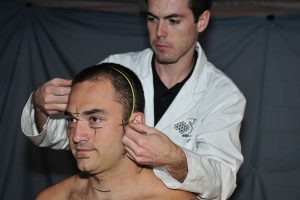Body scans and future military
By Lookout on Oct 01, 2012 with Comments 0

OS Scott Hickey, marine systems engineer student from Fleet School volunteered to take part in the 2012 Canadian Forces Anthropometric Survey. This is the first time a survey has ever been conducted across the Canadian Forces to establish data on the size and form of a range of military members.
Last week, the upper level of the Naden Gym took on the look and feel of a scientific research lab.
Dressed in blue robes, 180 CFB Esquimalt members had lines and x’s drawn on them before they were measured and guided behind curtains where three-dimensional lasers mapped out images of their bodies.
It looked like a scene from a sci-fi movie.
This was part of the 2012 Canadian Forces Anthropometric Survey, a Canadian Forces wide study involving 15 bases and wings.
The study is being conducted for the Canadian Forces by Defence Research and Development Canada, an agency that provides DND, other government departments and the public safety and national security communities with the knowledge and technologies needed to defend and protect Canada’s interests at home and abroad.
“This is the first time the Canadian Forces have done a study like this involving navy, army and air force,” said Allan Keefe, project lead from Defence Research and Development Canada (DRDC).
Current clothing and workspace standards are based on an army survey conducted in 1997, and there was evidence to suggest the survey needed to be updated, he says.
“Knowledge of the size and form of the body of Canadian Forces personnel is crucial to properly specify, evaluate, and develop military equipment and individual clothing,” said Keefe.
“We are taking a proportionate sampling approach to ensure we have proper representation of gender, occupation, age and language. This allows us to get a non-bias snapshot of the body shape and size of the Canadian Forces population today.”
Once all the data is analyzed it will be used for understanding how many of each size of clothing to buy, and improving fit and performance of equipment.
For the survey, participants began the process at an intake desk where they provided voluntary demographic information such as age, occupation and ethnicity. Then they proceeded to land-marking stations where important anatomical features were marked.
“This is done to aid the technicians in identifying key measurement locations on the body,” explained Keefe. “They are measured with measuring tape, callipers and anthropometers to provide us with body size info.”
Three dimensional scanners were then used to render accurate images of the participant’s head, hands, feet and full body.
About 40 military members participated in the study each workday at the Naden Athletic Centre last week.
Upon completion of the process, each participant received a certificate with an image of their body rendered by the 3D scanner.
The members who participated in the survey see the benefit in it, said Keefe. “They are curious as to when they will see the results of the data in new design of kit.”
This study is being led by DRDC with assistance from Human Systems Inc., and will assess 4,000 members across Canada.
Shelley Lipke, Staff Writer
Filed Under: Top Stories
About the Author:





